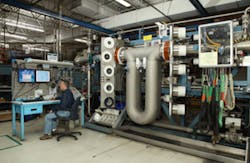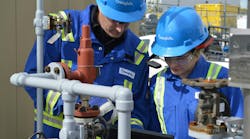Flow Control recently reached out to experts in the fluid handling industry through its LinkedIn page with the aim of gathering insights and best practices on the dark science that is flowmeter calibration. The response was tremendous, so we turned the feedback we received into a roundtable discussion, which we present to you here. We hope you find it useful and informative.
Thanks to all of the experts who provided feedback for this article. We also thank those who reached out to us, but were not included. Unfortunately, we had to limit the number of sources to keep the article manageable from a reader’s perspective. If you have insights to share, we encourage you to visit Flow Control on LinkedIn at and respond to our Flowmeter Calibration post there.
Q: How do you determine when it is the correct time to calibrate a flowmeter? What factors come into play?
Ballard: Our ultrasonic meters are calibrated initially when they leave the factory. Given that there is little-to-no drift and no moving mechanicals with ultrasonic, the most important calibration takes place with the initial calibration. Certain applications, like flare metering or custody transfer, have calibration or verification requirements by government bodies, which come into play when determining the correct time to calibrate.
Collins: Typically you calibrate monthly for field proving on a dedicated product. Exceptions include:
- Possibly several times per day on multiple products transported in single pipeline.
- Factory calibration upon determination of the following: unacceptable repeatability of prover pass, K-Factor or meter factor repeatability.
- Inability to meet field validation requirements.
- Unstable flowrate or accumulated total indication/signal transmission—beyond normal diagnostic remedies.
Kegel: The U.S. does not have legal metrology; therefore, there is no exact calibration interval. Basically it comes down to risk management. How important is the measurement? At CEESI we have a Statistical Process Control (SPC) program to help clients determine the correct interval and monitor the historical data for them.
A good example of control charts comes from traditional liquid hydrocarbon measurement. API standards describe how to monitor the proving (calibration) process.
Calibration is like insurance; you pay premiums year-after-year and never make a claim. It is tempting to wonder why you are paying out. Then your car is in an accident, or your roof is damaged in a hail storm, and you are reminded why you paid those premiums.
A cost-benefit analysis can be helpful. Suppose re-calibration identifies a 0.2 percent shift. What is the cost of 0.2 percent of the commodity being measured? What is the payback period?
Rouse: Two things govern flowmeter recalibration:
- Quality system requirements. Many quality systems specify a set recalibration periodicity. Generally this is annually; although some food and pharmaceutical companies are on a six month cycle. Note, it is a common misconception, but ISO does not specify recalibration periods; it only talks about the general record-keeping requirements around the process.
- Drift. Virtually all sensors drift from their factory calibration. This can be attributed to dirt buildup, aging of the electronics, physical changes in the sensor, and other causes.
This drift causes inaccuracies or offsets and requires the sensor to be recalibrated. Some companies have validation routines that allow the performance of the sensor to be benchmarked in the field against the original factory calibration. In most cases, however, if the sensor does not pass this validation, the instrument must still be sent back to the factory or to a calibration facility for service and recalibration.
Stappert: For the most part, calibration intervals on flowmeters are specified by regulation or determined by historic record and process condition. Intelligent flowmeters, like Coriolis and ultrasonic, have diagnostics that identify when a meter’s performance is outside of normal limits. These capabilities can be used to mitigate fiscal risk between calibration intervals or extend calibration intervals. What factors come into play? Factors that affect calibration intervals are the severity of the service, which includes dirty processes, two-phase, surging applications, high and low temperature, level of fiscal & HSE risk attributable to measurement. These same factors also determine the frequency of calibration.
Q: How do the type of application(s) the flowmeter is being used for affect the frequency/necessity of calibration?
Ballard: For us, applications that are most critical typically have a calibration or verification requirement. On our side, those are most common in flare metering and custody transfer. For flare metering, a yearly zero test is required by the Environmental Protection Agency (EPA) in the U.S. to meet air quality standards. In gas custody transfer in Canada, for example, re-calibrations are mandated every five years at a lab. In liquid custody transfer, installations are often proved in the field, the frequency of which is written into contract and follows API standards.
Collins: Excessive suspended solids, sand, pipeline rouge, etc., from an abrasive or corrosive process definitely require close scrutiny and inspection of the test meter. Also, entrained air/gas can impact liquid measurement.
Grimley: Meter calibration is largely a risk mitigation activity. The larger the potential risk (typically financial), the more benefit there is to calibrating a flowmeter.
Kegel: Different flowmeters require different maintenance schedules. For example, a sonic nozzle with no moving parts used on a clean dry gas would require less frequent calibrations than a turbine meter that has a gas or liquid with particulates in the flow stream.
Custody transfer vs. process monitoring/control: Process control generally requires no calibration, only repeatability and reproducibility. Often custody transfer contracts will specify calibration frequency. Companies with ISO 9000-type quality systems will often specify calibration intervals.
Rouse: Referring back to the two primary reasons for recalibration:
If the sensor is in a critical application, such as safety and health, the calibration cycle may be shortened. Likewise, if the sensor is critical to an expensive process.
Very dirty environments or extreme heat, pressure, vibration, etc. can exacerbate the drift process. This, in turn, leads to more frequent cleaning and recalibration.
Stappert: Dirty processes can cause pipe and flow conditioner build-up, inducing abnormal flow velocity profiles for meters like orifice, turbine, v-cone, ultrasonic, wedge, vortex, etc. that are sensitive to this change. Dirt and debris can build up on the internal flow diameter of the flowmeter, reducing flow diameter, increasing flow velocity, and inducing over registration. Flowmeters that utilize density measurement to infer volume from mass are susceptible to density error caused by coating of the meter flow element. Turbine meters are highly sensitive to Reynolds number change, change in fluid density, viscosity and flowrate, which may dictate the need for recalibration. Corrosive or erosive fluids will drive the need for more frequent calibrations. Surging applications (well production, engine and boiler fuel start-up flows) are extremely damaging to flowmeters with rotating elements (turbine and positive displacement meters).
RELATED: To Calibrate or Not to Calibrate — Understanding when and why your flowmeters need to be calibrated
Q: What are some of the problems that can occur when a flowmeter is not calibrated properly or at all?
Ballard: Very simply, you have greater uncertainty of the installation. Calibration provides certainty of the measurement. While some meters perform very well uncalibrated, there will be no certainty of the installation unless there is calibration compared to a traceable reference.
Collins: Consistent errors in anticipated mass/volumetric flowrate and/or accumulated volume, often results in fiscal over/under measurement, and erroneous flow control operation.
Grimley: Improper calibration of a flowmeter or, more commonly, improper use of flow calibration data can create bias errors in the flow measurement that can lead to operational issues, such as a system imbalance, billing issues, or errors in efficiency calculations, just to name a few examples. Improper use of calibration data can happen, for example, when the calibration corrections are implemented both in the meter and in the associated flow computer. In some cases the manufacturer’s "out of the box" specification may be sufficient for the desired uncertainty, but if the meter is not validated in some manner prior to use, then questions may arise later regarding the actual meter performance vs. the claimed meter performance. Even the best manufacturer’s occasionally produce a lemon—a meter calibration will normally catch and/or correct that issue.
Kegel: The easy answer is a mismeasurement. The magnitude could be unknown.
Rouse: The obvious problem [with not calibrating flowmeters] is the degradation in performance of the flowmeter. Accuracy is critical in many processes. The clearest example is in a flowmeter used for billing (custody transfer). An inaccurate flowmeter is going to cost either the supplier or the customer money depending on whom the error falls in favor of.
Likewise, processes that use bioreactors or chemical reactions depend on precisely measured reactants to make consistent product.
Stappert: Over-registration (grandma eats dog food), under-registration (stockholders eat dog food), non-compliance with regulation … product quality and quantity out of tolerance (fiscal and regulatory liability).
Q: Have stricter government mandates increased the need for flowmeter calibration? How?
Ballard: Absolutely—refer to my examples in answer No. 2. In addition, government bodies, such as in Norway, have very specific guidelines for meter calibration and proving.
Collins: Examples would be TNRRC, BLM and EPA’s scrutiny on technology and performance.
Kegel: We are seeing an increase in calibrations for different sectors based on government mandates. The EPA has put in place stricter regulations on flare metering, and therefore the need for calibrations is becoming a bigger part of that application.
Carbon monitoring is driving some recalibration activities. Process plants are needing to use meters originally installed for monitoring or control functions and use them to measure carbon. Carbon monitoring and other environmental regulations are becoming a new form of custody transfer.
Some government regulators want to see quality documentation that includes re-calibration intervals. CEESI’s experience says that FDA, NRC, and FAA are some of the more demanding agencies in this regard.
CEESI does quite a bit of work for overseas customers. In general, we find that most overseas customers face a larger regulatory burden than we see here in the U.S.
Rouse: Government regulation has had an impact, particularly in the field of emissions control. Federal, state, and local regulations require the measurement of combustion and greenhouse gases in many processes, and these regulations are expanding. These laws specify certain methods and the periodicity of recalibration for the flowmeters used. Even when they do not explicitly do so, many companies measure these emissions for the purposes of carbon offsets, waste gas recovery, or to avoid hefty fines. The measurement of flare gases in the oil and gas fields are examples of this.
Stappert: Tighter regulation on product quality, quantity, health, safety, and environmental protection have created mandates on calibration interval and practice. The potential liability of regulatory non-compliance has driven users to self regulate their calibration practice.
Q: What are some common pitfalls end-users encounter/fall into when it comes to flowmeter calibration?
Ballard: Probably the most common pitfall that I see is installation effects. Even at labs that are certified to ISO17025 and have traceable primary references, piping and installation effects of the meter commonly cause issues at the lab. Installation is also one of the largest sources of uncertainty when transferring calibrations from the lab to the field—as piping arrangements may change—affecting the flow profile within the pipe.
Collins: Inability to challenge the technology, and method, used for the calibration/proving, ergo the resultant data [are common pitfalls]. Also, accepting volumetric calibration/proving methods for mass meters.
Kegel: I would say the largest pitfall is not calibrating to a customer’s application. Correct parameters for each different type of flowmeter can be a large factor in performing a correct calibration; along with inlet and exit conditions to match the end-user’s particular situations.
Surrogate fluid calibration is common. A customer might be measuring heavy oil, but water is used as a surrogate calibration fluid. Similarly, a meter for steam service may be calibrated with compressed air. The test programs need to be carefully planned taking into account the meter type and application parameters.
Grimley: From the perspective of a flowmeter calibration facility, one of the most common issues that we see is a failure to plan ahead for scheduling the meter calibration. The lead time for a calibration in most gas flow facilities is generally one or more months, so good planning is essential. Understanding what portions of the meter installation actually need to be sent to the flow lab is also critical in obtaining a proper calibration. This varies greatly with the meter type.
Rouse: A key pitfall is field validation as in-situ calibration. A field validation is a comparison of the flowmeter performance to the benchmark of its factory calibration to look for drift. If drift is found, the flowmeter generally needs to be sent back to the factory. Many companies are marketing this as an "in-situ" calibration. In-situ means "in place," implying that the flowmeter can be recalibrated in the field. Most often this is not the case since, as stated above, most industrial flow recalibration assets are not portable.
Stappert: Blind trust (trust but no verification) of their calibration references; calibration of instruments outside of the reproducible condition limits of the technology being calibrated.
Q: How do you see the issue of flowmeter calibration evolving going forward? Are there any technology or application trends that will influence the flowmeter calibration process in the future?
Ballard: There is definitely a trend in reducing the need and frequency of calibration. This is currently being looked at using advanced diagnostics and compensation algorithms. Diagnostics also help speed up the calibration process by providing more real-time information. In the future—as a manufacturer—we (GE) would like to be able to guarantee uncertainty without calibration, while still achieving the highest levels of accuracy.
Collins: Need for more competent personnel to witnesses the calibration of the calibrator/prover, i.e., waterdraw method, NIST traceable components, methodology, compliance with published and acceptable standards, such as API, NIST Handbook 44, etc.
Kegel: We see all different industries require low uncertainty calibrations. There is a larger emphasis on the importance of flowmeter calibrations and the measurements these devices are performing.
Grimley: Even with advances in electronics and a greater understanding of the physics involved in the measurement process, meter calibration will remain a vital part of measurement because it reduces the risk associated with measurement errors. Meter diagnostics will continue to evolve and provide indications of apparent shifts in meter operation, but the ability to link diagnostics to particular error levels will have to evolve to allow diagnostics to trigger recalibration requirements.
Rouse: The key is to make a true in-situ calibration. No one likes to send a flowmeter back to the factory for recalibration. It costs down time, is inconvenient, and adversely affects the process. The trend is toward portable calibration assets like piston provers for the smaller flowrates. For the industrial flowmeters, the trend is to reduce or eliminate sensor drift, then provide the tools to validate that there has been minimal drift in the field, thus pushing out the need to recalibrate.
Stappert: Master Metering with highly reproducible flowmeters will become more common. The on-line diagnostics of intelligent flowmeters will begin to govern calibration interval. Master metering Coriolis meters will most likely have the biggest impact on flowmeter calibration practice in the future.
Jake Mastroianni is the former managing editor of Flow Control magazine and FlowControlNetwork.com. For questions and comments about this article, please contact Matt Migliore at [email protected] or 610 828-1711.










